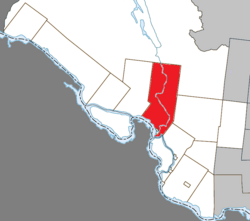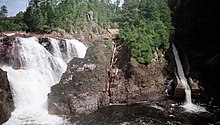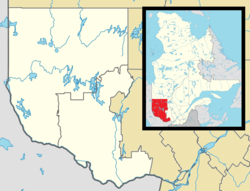Mansfield-et-Pontefract is a municipality in the Pontiac Regional County Municipality of western Quebec, Canada. It is located on the Ottawa River, northwest of Gatineau. It is the most populated municipality in the Pontiac Regional County Municipality, with most of the population and businesses concentrated along Quebec Route 148.[4]
Mansfield-et-Pontefract | |
|---|---|
 | |
 Location within Pontiac RCM | |
| Coordinates: 45°51′40″N 76°44′21″W / 45.86111°N 76.73917°W[1] | |
| Country | Canada |
| Province | Quebec |
| Region | Outaouais |
| RCM | Pontiac |
| Constituted | January 1, 1868 |
| Government | |
| • Mayor | Sandra Armstrong |
| • Federal riding | Pontiac |
| • Prov. riding | Pontiac |
| Area | |
• Total | 523.45 km2 (202.11 sq mi) |
| • Land | 466.61 km2 (180.16 sq mi) |
| Population (2021)[3] | |
• Total | 2,250 |
| • Density | 4.8/km2 (12/sq mi) |
| • Pop (2016-21) | |
| • Dwellings | 1,074 |
| Time zone | UTC−5 (EST) |
| • Summer (DST) | UTC−4 (EDT) |
| Postal code(s) | |
| Area code | 819 |
| Highways | |
| Website | www |


It is home to the main tourist attractions of the Pontiac region: the Chutes Coulonge, the George Bryson House, and the Félix-Gabriel-Marchand Bridge.
Communities
edit- Davidson
- Dépôt Davidson
- Devonshire Park
- Jim Lake
- Leclair
- Mansfield
History
editIn 1849, the Mansfield Township was formed that was incorporated as a township municipality in 1855. It may have been named after an English town in Nottinghamshire or in honour of Sir James Mansfield (1733-1821), Solicitor General of Canada in 1780, or William Murray, 1st Earl of Mansfield (1705–1793). In 1863, Pontefract Township was officially established, named after an English town in Yorkshire.[1]
On January 1, 1868, the townships were merged to form the United Township Municipality of Mansfield-et-Pontefract. In 1888, a portion of its territory separated and was incorporated as the Village Municipality of Fort-Coulonge. In 2003, Mansfield-et-Pontefract changed its status from united township municipality to an ordinary municipality.[1]
Demographics
editPopulation
edit| 2021 | 2016 | 2011 | |
|---|---|---|---|
| Population | 2,250 (-1.5% from 2016) | 2,285 (3.7% from 2011) | 2,204 (+6.2% from 2006) |
| Land area | 466.61 km2 (180.16 sq mi) | 477.44 km2 (184.34 sq mi) | 474.80 km2 (183.32 sq mi) |
| Population density | 4.8/km2 (12/sq mi) | 4.8/km2 (12/sq mi) | 4.6/km2 (12/sq mi) |
| Median age | 49.2 (M: 49.2, F: 49.2) | 47.1 (M: 47.1, F: 47.0) | 44.3 (M: 44.5, F: 44.2) |
| Private dwellings | 1,074 (total) 883 (occupied) | 1,113 (total) | 1,030 (total) |
| Median household income | $76,500 | $61,664 | $.N/A |
|
| ||||||||||||||||||||||||||||||||||||
| 2006 data based on adjustment following Census publication. Source: Statistics Canada[10] | |||||||||||||||||||||||||||||||||||||
Language
editMother tongue (2021):[3]
- English as first language: 17.8%
- French as first language: 77.6%
- English and French as first language: 4.1%
- Other as first language: 0.5%
See also
editReferences
edit- ^ a b c "Mansfield-et-Pontefract (Municipalité)" (in French). Commission de toponymie du Québec. Retrieved 2011-04-11.
- ^ a b "Mansfield-et-Pontefract". Ministère des Affaires municipales et de l'Habitation (in French). Retrieved 26 October 2022.
- ^ a b c "Mansfield-et-Pontefract, Municipalité (MÉ) Census Profile, 2021 Census of Population". www12.statcan.gc.ca. Government of Canada - Statistics Canada. Retrieved 26 October 2022.
- ^ Lisa Corrigan. "Municipality". Municipality of Mansfield-et-Pontefract. Retrieved 2011-04-12.
- ^ "2021 Community Profiles". 2021 Canadian census. Statistics Canada. February 4, 2022. Retrieved 2023-10-19.
- ^ "2016 Community Profiles". 2016 Canadian census. Statistics Canada. August 12, 2021. Retrieved 2019-11-22.
- ^ "2011 Community Profiles". 2011 Canadian census. Statistics Canada. March 21, 2019. Retrieved 2014-01-28.
- ^ "2006 Community Profiles". 2006 Canadian census. Statistics Canada. August 20, 2019.
- ^ "2001 Community Profiles". 2001 Canadian census. Statistics Canada. July 18, 2021.
- ^ 1996, 2001, 2006, 2011 census
